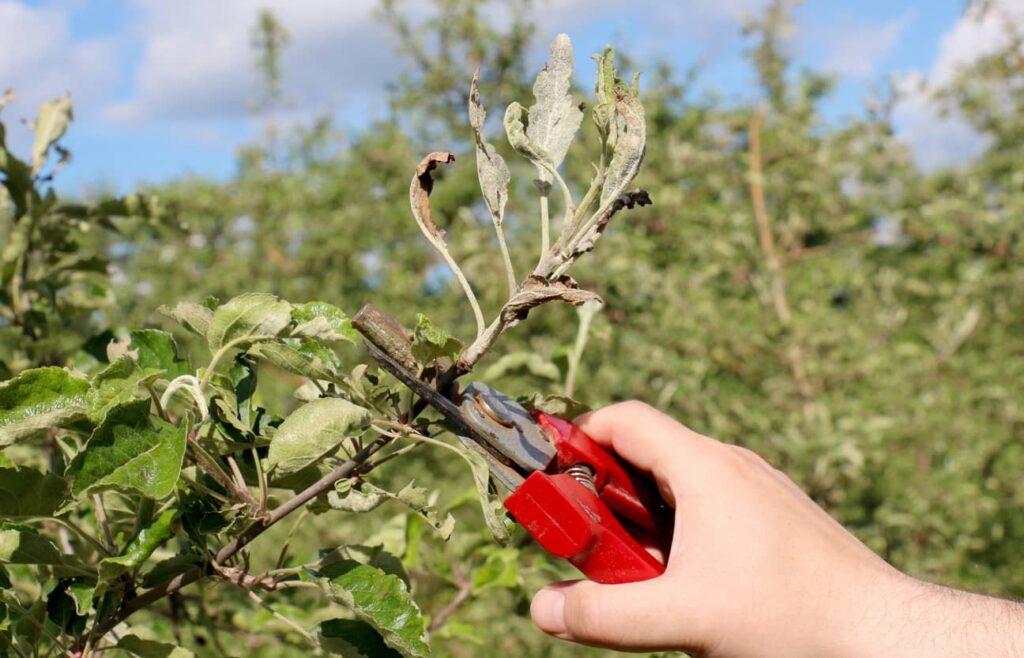Growing plants is something that many homeowners do. Some have an easier time than others. This is because some plants are easy and you just let mother nature water them, while others take some work. Sometimes a lot of work. Many plants end up with parasites and other enemies of plants so a homeowner needs to watch the garden to keep them away. Powdery mildew can be seen on plants leading some to wonder – is powdery mildew harmful to humans? It is not a direct threat to humans but can be indirectly harmful if a person is allergic to mold.

What Is Powdery Mildew?
Known as a silent killer of plants, powdery mildew is a fungal disease also known as white mold. Unfortunately, it affects a lot of plants. Caused by species of the Erysiphales fungi, different types of this fungi will infest other plants.
This happens because the powdery mildew spores are spread through the air inside and also where plants grow. The spores can also be spread by contact with tools, humans brushing against plants and animals.
The fungus reproduces quickly so if you don’t find it right away, the crops can be destroyed. However, if you watch the crops, you can keep an eye out for when it is starting. It can be controlled by various chemicals and other methods.
What Does it Look Like?
It is important to know what this mildew looks like on an infected plant.
- White patches that are powder-like and circular are on the leaves and stems.
- Lower leaves are usually affected the most and spots can appear on any part of the plant.
- It will cover the upper side of the leaves but also sometimes grows underneath.
- Leaves will turn yellow on the plant and dry out.
- Spores will be larger and thicker as the mildew spreads and forms a mat over the surface.
- Buds and growing tips and leaves will become disfigured.
- Foliage will be distorted and stunted as the infection becomes more severe.
What Causes Powdery Mildew?
Most fungal diseases like humidity and moisture, but not powdery mildew. It actually likes dry and warm conditions to grow. It won’t spread in areas that are rainy and cool. Let’s look at the main causes:
- Poor Airflow – high humidity combined with airflow that is limited, allows the spores to grab onto the plants and reproduce.
- Leaf to leaf Contact – when the leaves of the plants are touching each other, moisture starts to form. You can prevent this by pruning the leaves and placing the plants farther apart so they are not touching.
Is it Harmful?
As mentioned earlier, powdery mildew is not directly harmful to humans but can be indirectly harmful. If you touch it, it won’t hurt you but if you have an allergy to mold, you may have a reaction to it. Plants are the ones that are the most affected and it can infest a lot of plants. This ranges from grass to flowers, grains, fruits and vegetables. This white powdery mold also keeps your plants from blooming and can kill them. Plants with powdery mildew need to be taken care of right away.
Where Does Powdery Mildew Grow?
This mildew, as mentioned earlier, grows anywhere that it can find the conditions that it likes. It can be in a garden, greenhouse, or field. There are some plants that it affects too and you need to treat the powdery mildew.
- barley
- zucchini
- peonies
- tomato
- roses
- grass
- cucumber
- other vegetable plants
Getting Rid of Powdery Mildew
There are ways to get rid of this plant disease as soon as you see the white mold. Even though we’ve learned that powdery mildew isn’t harmful to humans, it’s still a threat to our plant children.
Firstly, you can combine 1 part milk and 9 parts water in a spray bottle. Then, coat the plant that has the infection with the mixture. Do this every week until the mold dissipates.
Baking Soda
Also, baking soda solutions are an effective home remedy to treat powdery mildew. You can also use this in multiple areas such as the garden and preventing, or getting rid of powdery mildew. To make this home remedy:
- One tablespoon of baking soda combined with 1 quart of warm water. Let it dissolve.
- Put this into a spray bottle and drench the infected plant. It only works if sprayed on the fungus.
- Add horticultural oil to the mixture if you want to boost potency.
- You can add two tablespoons of horticultural oil to the mixture to improve its effectiveness.
- Adding a couple of drops of liquid soap to the mix also helps it stick to the leaves.
Apple Cider Vinegar
For years, people have been using apple cider vinegar to prevent and kill powdery mildew. Here’s how to do this:
- Combine 2 teaspoons of apple cider vinegar and 1 quart of water and put into a spray bottle.
- Spray the plant with the solution frequently. Monitor the plant to make sure it is alive.
- You can also add a non-detergent liquid soak to the concoction to help it stick to the leaves.

Preventing Powdery Mildew
There are ways you can prevent and control powdery mildew from spreading! To begin, make sure to space the plants far enough from each other that air can circulate the leaves.
Then, water plants at the base, not from above. This helps ensure that their roots get moisture without allowing for excess water left behind. Finally, plants should have direct sunlight every day and this will help keep the white mold away.
Other Recommended Maintenance
Now that you have learned about powdery mildew on plants, let’s take a look at some other areas of maintenance. One of those is over-irrigation of the soil. Sometimes we think that the grass needs more watering than it does so it is easy to over irrigate the soil. Make sure you have a good drainage system and if it has been raining a lot, make sure the sprinklers are not coming on.
Next, another area is purifying the well water for drinking. This can be done by using a water filtration or water treatment system. This will keep your well free from contaminants. This is important because you want your well water clean.
Lastly, if you have ornamental grasses, you may want to know why they are turning brown. This is because they are either over-watered, under-watered, or they are dormant if it is wintertime.
When to Contact a Professional
If you notice the powdery white mildew starting to appear, it is time to take action. You can use the methods above or call a professional to get advice about how to treat your plants. You must take care of this as soon as possible as the mildew can take over. If it is too big of a job for you, reach out to a professional for assistance. Also, your local home inspection company can refer someone to help as well.
Conclusion
Growing plants takes time and effort and the last thing you want to do is lose them to powdery mildew. Keeping an eye out for growing conditions and taking care of any signs you see right away is important.
The good thing is powdery mildew isn’t directly harmful to humans, but if you are allergic to mold, you may have effects from it. If you have this mildew growing outside, you may need a home inspection company to check inside your home too. Reach out to Fox Mountain Property Inspections for a mold and air quality inspection during a full home inspection in MD, PA, VA, and WV.




